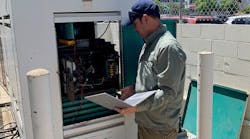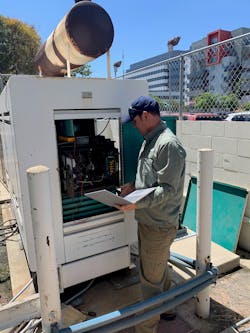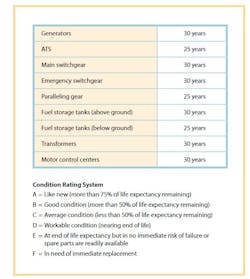Emergency medical responders in Los Angeles County, Calif., are shepherding deployment of new real-time monitoring and messaging technology that provides early warning of possible failures of backup hospital generators during power grid outages.
In a pilot program coordinated by the Los Angeles County (LAC) Emergency Medical Services (EMS) Agency, three county acute-care hospitals have activated the Power P.I.O.N.E.E.R. tool, which was developed by Powered for Patients, a Washington, D.C., non-profit that aims to better ensure critical healthcare facilities have functioning and reliable emergency power.
Los Angeles County was selected for the tool’s debut partly because many of its hospitals were found to rely on aging generators that are at comparatively higher risk of failure. Powered for Patients, contracted by LAC EMS to assist in a broad assessment of emergency power resilience for the county’s critical-care infrastructure, found in a recent study that 32% of 271 generators sited across 80 selected acute-care hospitals in the county were 30-plus years old, a marker for heightened operational risk. Furthermore, nine of the sample’s 14 acute-care hospitals that depend on a single on-site emergency generator have similarly aged units. In the wake of generator failures in recent storms, such as 2011’s Hurricane Sandy, more critical-care facilities are paying closer attention to generator conditions (see the Figure below).
Continuous generator monitoring and the collection and dissemination of live status data helps ensure care facilities avoid glitches when backup power must be used. It also can be timely in protecting lives. That’s where Powered for Patients’ tool, a first of its kind for a U.S. hospital, comes in. When fully enabled to Powered for Patients’ vision, says Project Director Eric Cote, it will offer a way to gauge the likelihood of imminent generator failure, giving government agencies, other responders, and resource providers time to assess the situation and coordinate actions to protect those in the facility. Remedies include evacuation and mobile generator placement to emergency servicing and utility feeder line adjustments.
“Gaining better awareness of generator status is especially critical for single-generator facilities that have no redundancy,” Cote says. “Early warning when there’s any hint of trouble would allow them to accelerate their response, whether that’s placement of a temporary generator for instance or, if one can’t be deployed, giving public officials a valuable head start on initiating evacuation plans.”
Functioning as a dashboard of sorts, Power P.I.O.N.E.E.R. is a Department of Homeland Security-funded adaptation of remote generator status monitoring technology developed by Schneider Electric, Automated Logic Corp., and Blue Pillar, Cote says. By adding a communications layer to that technology, it extends its value, offering the prospect of higher visibility of information and cross-communication, which leads to improved decision making and quicker response during power outages.
With the initial deployment underway, LAC EMS and Powered for Patients will be exploring ways to fully utilize the tool ahead of a planned expansion to more of the county’s at-risk healthcare facilities, which itself is just one part of a four-year effort LAC EMS is leading to assess healthcare system emergency power resilience, Cote says.
“One of the things we’ll be doing is fine-tuning the protocols around what alerts should warrant what response by government officials,” he says. “Our goal will be to create real-time situational awareness among all of the stakeholders who will need to make informed decisions.”
While the tool is focused on creating a dynamic communications loop among government emergency responders, Cote says it could also integrate service contractors that healthcare facilities use to maintain generator systems. Their awareness of emergency power issues as they’re happening and their readiness to advise or deploy might be a critical component of the overall response.
Tom Zind is a freelance writer based in Lees Summit, Mo. He can be reached at [email protected].





